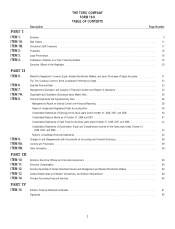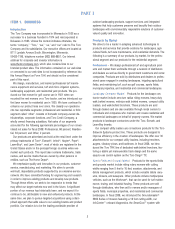Toro 2008 Annual Report Download - page 20
Download and view the complete annual report
Please find page 20 of the 2008 Toro annual report below. You can navigate through the pages in the report by either clicking on the pages listed below, or by using the keyword search tool below to find specific information within the annual report.•
reduced consumer and business spending, causing homeowners If we are unable to continue to enhance existing
not to outsource lawn care and causing landscape contractor products and develop and market new products that
professionals to forego or postpone purchases of our products; respond to customer needs and preferences and
•
reduced levels of commercial and residential construction, result- achieve market acceptance, we may experience a
ing in a decrease in demand for our products; and decrease in demand for our products, and our business
•
reduced levels of new golf course construction, reduced number could suffer.
of golf rounds played at public and private golf courses resulting One of our growth strategies is to develop innovative, customer-
in reduced revenue for such golf courses, decreased member- valued products to generate revenue growth. Our sales from new
ship at private golf courses resulting in reduced revenue and, in products in the past have represented a significant component of
certain cases, financial difficulties for such golf courses, and golf our net sales and are expected to continue to represent a signifi-
course closures, any of which can result in a decrease in spend- cant component of our future net sales. We may not be able to
ing and demand for our products. compete as effectively with our competitors, and ultimately satisfy
the needs and preferences of our customers, unless we can con-
Our residential segment net sales are dependant upon tinue to enhance existing products and develop new innovative
consumer spending levels, the amount of product products in the markets in which we compete. Product develop-
placement at retailers, changing buying patterns of ment requires significant financial, technological, and other
customers, and The Home Depot, Inc. as a major resources. Although in the past we have implemented Lean manu-
customer. facturing and other productivity improvement initiatives to provide
The elimination or reduction of shelf space assigned to our resi- investment funding for new products, we cannot be certain that we
dential products by retailers could adversely affect our residential will be able to continue to do so in the future. Product improve-
segment net sales. Our residential segment net sales are also ments and new product introductions also require significant plan-
dependent upon changing buying patterns of customers. For exam- ning, design, development, and testing at the technological, prod-
ple, there has been a trend away from purchases at dealer outlets uct, and manufacturing process levels and we may not be able to
and hardware retailers to home centers and mass retailers. This timely develop product improvements or new products. Our com-
trend has resulted in a demand for residential products purchased petitors’ new products may beat our products to market, be more
at retailers, such as The Home Depot, which accounted for effective with more features and/or less expensive than our prod-
approximately 10 percent or more of our total consolidated net ucts, obtain better market acceptance, or render our products
sales in each of fiscal 2008, 2007, and 2006. We believe that our obsolete. Any new products that we develop may not receive mar-
diverse distribution channels and customer base should reduce the ket acceptance or otherwise generate any meaningful net sales or
long-term impact on us if we were to lose The Home Depot or any profits for us relative to our expectations based on, among other
other substantial customer. However, the loss of any substantial things, existing and anticipated investments in manufacturing
customer, a significant reduction in sales to The Home Depot or capacity and commitments to fund advertising, marketing, promo-
other customers, or our inability to respond to future changes in tional programs, and research and development.
buying patterns of customers and new distribution channels could
have a material impact on our business and operating results. We face intense competition in all of our product lines
Changing buying patterns of customers also could result in with numerous manufacturers, including from some that
reduced sales of one or more of our residential segment products, have greater operations and financial resources than us.
resulting in increased inventory levels. Although our residential We may not be able to compete effectively against
lawn and garden products are generally manufactured throughout competitors’ actions, which could harm our business
the year, our residential snow removal equipment products are and operating results.
generally manufactured in the summer and fall months. Our pro- Our products are sold in highly competitive markets throughout the
duction levels and inventory management goals are based on esti- world. Principal competitive factors in our markets include pricing,
mates of demand for our products, taking into account production product innovation, quality and reliability, product support and cus-
capacity, timing of shipments, and field inventory levels. If we over- tomer service, warranty, brand awareness, reputation, distribution,
estimate or underestimate demand during a given season, we may shelf space, and financing options. We compete in all of our prod-
not maintain appropriate inventory levels, which would negatively uct lines with numerous manufacturers, some which have substan-
impact our working capital or hinder our ability to meet customer tially greater operations and financial resources than us. As a
demand. result, they may be able to adapt more quickly to new or emerging
technologies and changes in customer preferences, or to devote
greater resources to the promotion and sale of their products than
we can. In addition, competition could increase if new companies
12
























